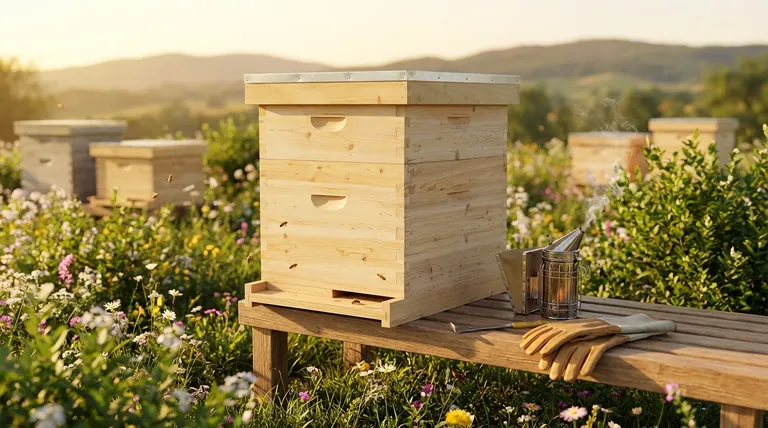At its core, the Langstroth hive is recommended for beginners because its widespread adoption has created an unparalleled ecosystem of support. This standardization makes it significantly easier to find compatible equipment from any supplier and to access a vast pool of experienced mentors who use the exact same system.
Choosing your first beehive is a foundational decision that impacts your entire learning experience. The primary reason for the Langstroth recommendation is not necessarily the superiority of the hive design itself, but the strength of the community and industry that has been built around its universal standard.

The Power of a Universal Standard
The Langstroth hive, developed in the 1850s, became the de facto standard for modern beekeeping. This universal adoption is its single greatest advantage for a newcomer.
Unmatched Equipment Availability
Because nearly all commercial and a majority of hobbyist beekeepers use Langstroth hives, manufacturers produce components in massive quantities. This means hive bodies, frames, and accessories are inexpensive and readily available from countless suppliers.
You can buy a hive box from one company and be certain that frames from another company will fit perfectly. This interchangeability removes significant guesswork and frustration for a beginner.
A Deep Well of Knowledge
The vast majority of beekeeping books, online videos, and local club mentors will be teaching based on the Langstroth system. It is the common language of beekeeping.
When you have a problem or question, you can be confident that the advice you receive will apply directly to your equipment. This direct translation of knowledge is invaluable during your first few seasons.
Designed for Management and Scalability
The Langstroth's modular, stackable box design is inherently flexible. As your colony grows, you simply add more boxes. If a component gets damaged, it can be easily replaced.
This system was designed for efficient inspection and management, which is critical for learning to identify pests, diseases, and the overall health of your colony. Its compatibility with mechanized equipment is why it dominates commercial beekeeping, and that same efficiency benefits the hobbyist.
Understanding the Trade-offs
While the Langstroth is an excellent starting point, it is not without its challenges. Being aware of the trade-offs provides a more complete picture.
The Learning Curve of Honey Extraction
Harvesting honey from a Langstroth hive is a multi-step process. It involves removing heavy frames, uncapping wax cappings with a knife or scraper, and using a centrifugal extractor to spin the honey out.
This process requires purchasing or borrowing separate, dedicated extraction equipment. It stands in contrast to systems like the Flow Hive, which are designed specifically to simplify the harvesting step at the expense of higher cost and less standardization.
Physical Demands
A standard 10-frame Langstroth "deep" box, full of honey, can weigh over 80 pounds (36 kg). Managing a hive often requires lifting these heavy boxes, which can be a significant physical challenge for some individuals.
A Focus on Intervention
The Langstroth system is designed for active management. While this is excellent for learning, some beekeepers prefer a more "natural" or less intrusive approach.
Alternative hives, such as Top Bar or Warre hives, are often chosen by those who wish to intervene less in the colony's natural processes, but they come with a much smaller support community and less standardized equipment.
Making the Right Choice for Your Goal
Your first hive should align with your primary goals as a new beekeeper.
- If your primary focus is a supportive learning environment: The Langstroth is the undisputed choice due to its vast resources and standardized parts.
- If your primary focus is the simplest possible honey harvest: You might investigate a Flow Hive, but understand you are trading broad community support for convenience in one specific task.
- If your primary focus is a "hands-off" or natural approach: Research Top Bar or Warre hives, accepting that you will have a steeper learning curve with a smaller support network.
Ultimately, starting with a Langstroth hive sets you on the most well-traveled path, minimizing early frustrations and maximizing your access to help.
Summary Table:
| Feature | Benefit for Beginners |
|---|---|
| Universal Standard | Easy to find parts & get advice from any supplier or mentor. |
| Wide Equipment Availability | Inexpensive, interchangeable components from many suppliers. |
| Vast Knowledge Base | Most books, videos, and clubs teach the Langstroth system. |
| Modular & Scalable Design | Easy to expand your apiary as your colony grows. |
Ready to Start Your Beekeeping Journey with the Right Equipment?
As a beginner, having reliable, standardized equipment is key to a successful start. HONESTBEE supplies high-quality Langstroth hive components and beekeeping supplies to commercial apiaries and distributors through our wholesale-focused operations. We provide the foundational equipment that makes learning beekeeping easier and more efficient.
Contact our team today to discuss your wholesale needs and let us equip you for success from day one.
Visual Guide

Related Products
- Langstroth Bee Hives Bee Keeping Box for Beginners Beekeeping
- Long Langstroth Style Horizontal Top Bar Hive for Wholesale
- HONESTBEE Professional Multi-Functional Hive Tool with Ergonomic Wood Handle
- HONESTBEE Professional Long Handled Hive Tool with Precision Cutting Blade
- Multi-Function Plier-Style Frame Grip Hive Tool
People Also Ask
- Why might a beginner be advised to start with a Langstroth hive? Unlock a Supportive Beekeeping Ecosystem
- How does the ease of access differ between 8-frame and 10-frame hives? Choose the Right Hive for Your Body
- How does the orientation of the hive sides benefit comb construction? Ensure Straight, Movable Combs for Easier Hive Management
- What basic equipment is needed to start beekeeping? Your Essential Guide to a Confident Start
- Why were wooden hives traditionally preferred? For Natural Beekeeping Aligned with Bee Biology



















